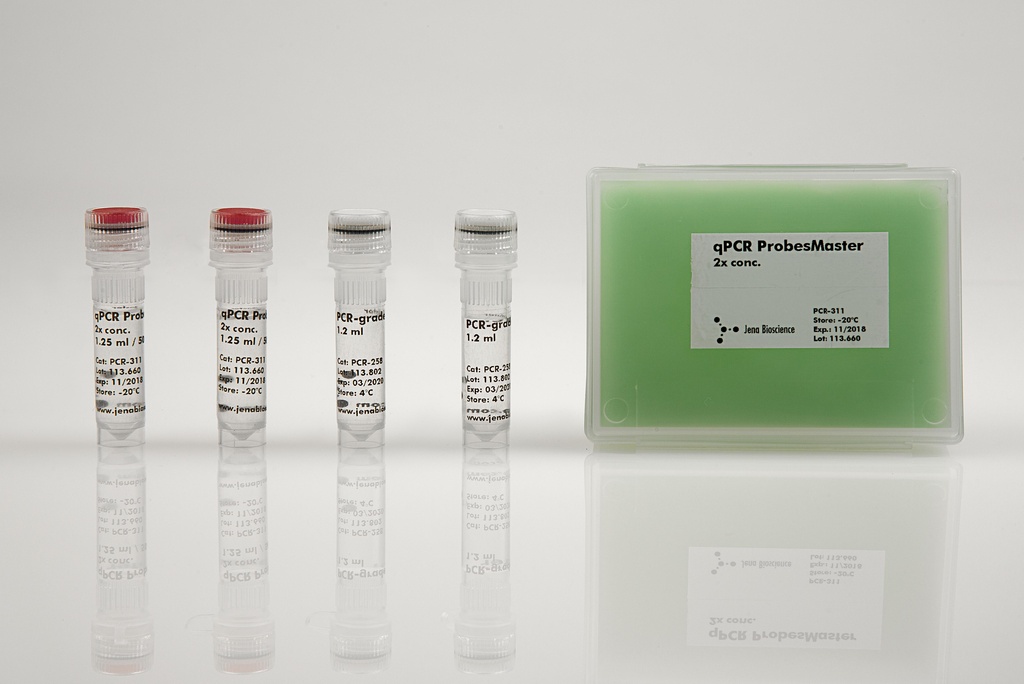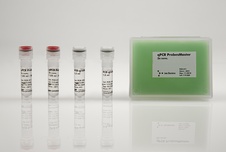qPCR ProbesMaster UNG, 2 x 1,25 ml (2x conc.)
Detailní popis
For general laboratory use.
Shipping: shipped on gel packs
Storage Conditions: store at -20 °C
avoid freeze/thaw cycles
Storage at 4 °C for up to 3 months possible.
Shelf Life: 12 months
Form: liquid
Concentration: 2x conc.
Description:
qPCR ProbesMaster UNG is designed for quantitative real-time analysis of DNA samples using DNA probe based detection. The master mix is recommended for use with Dual Labeled Fluorescent Probes, e.g. TaqMan®, Molecular Beacons or FRET probes. It provides an easy-to-handle and powerful tool for quantification of sample DNA in a broad dynamic range of up to 6 orders of magnitude with exceptional sensitivity and precision.
The mix contains all reagents required for qPCR (except template, primer and labeled fluorescent probe) in a premixed 2x concentrated ready-to-use solution. The high specificity and sensitivity of the mix based on an optimized hot-start polymerase. Its activity is blocked by antibody at ambient temperature and switched on automatically at the onset of the initial denaturation. The thermal activation prevents the extension of nonspecifically annealed primers and primer-dimer formation at low temperatures during PCR setup.
The mix contains UNG (Uracil-N-Glycosylase) and dUTP instead of dTTP to eliminate carry-over contamination of DNA from previous PCR reactions. The UNG treatment at the onset of thermal cycling removes uracil residues from dU-containing DNA and prevents it from serving as template.
The mix can also be used in combination with ROX reference dye (#PCR-351) in PCR instruments that are compatible with the evaluation of the ROX signal.
Dual-labeled DNA probes:
Real-time PCR technology based on dual-labeled DNA probes provides a high sensitive and high specific PCR system with multiplexing capability. It requires two standard PCR primers and the DNA probe that hybridizes to an internal part of the amplicon. The sequence of the dual-labeled DNA probe should avoid secondary structure and primer-dimer formation.
Content:
qPCR ProbesMaster UNG (red cap)
antibody-blocked hot start polymerase, UNG, dATP, dCTP, dGTP, dUTP, KCl, (NH4)2SO4, MgCl2, additives and stabilizers
PCR-grade water
Preparation of the qPCR master mix:
The preparation of a master mix is crucial in quantitative PCR reactions to reduce pipetting errors. Prepare a master mix of all components except template as specified. A reaction volume of 20-50 μl is recommended for most real-time instruments. Prepare 13 volumes of master mix for 12 samples or a triple-set of 4 samples. Pipet with sterile filter tips and minimize the exposure of the labeled DNA probe to light. Perform the setup in an area separate from DNA preparation or analysis. No-template controls should be included in all amplifications.
| component | 20 μl assay |
50 μl assay |
final conc. |
| qPCR ProbesMaster with UNG | 10 μl | 25 μl | 1x |
| primer forward (10 μM)1) |
0.6 μl | 1.5 μl | 300 nM |
| primer reverse (10 μM)1) |
0.6 μl | 1.5 μl | 300 nM |
| dual-labeled probe (10 μM)2) |
0.4 μl | 1 μl | 200 nM |
| template DNA | x μl | x μl | <500 ng/assay |
| PCR-grade water | fill up to 20 μl |
fill up to 50 μl |
- |
1) The optimal concentration of each primer may vary from 100 to 500 nM.
2) Optimal results may require a titration of DNA probe concentration between 50 and 800 nM.
Dispensing the master mix:
Vortex the master mix thoroughly to assure homogeneity and dispense the mix into real-time PCR tubes or wells of the PCR plate.
Addition of template DNA:
Add the remaining x μl of sample/template DNA to each reaction vessel containing the master mix and cap or seal the tubes/plate. Do not exceed 500 ng DNA per reaction as final concentration. Tubes or plates should be centrifuged before cycling to remove possible bubbles.
Recommended cycling conditions:
| UNG treatment3) | 50 °C | 2 min | 1x |
| Initial denaturation and polymerase activation |
95 °C | 2 min | 1x |
| Denaturation | 95 °C | 15 sec | 35-45x |
| Annealing and elongation |
60-65 °C4) | 1 min5) | 35-45x |
3) Cycling step 1 is only required if an UNG (Uracil-N-Glycosylase) treatment is applied.
4) The annealing temperature depends on the melting temperature of the primers and DNA probe used.
5) The elongation time depends on the length of the amplicon. A time of 1 min for a fragment of up to 500 bp is recommended.
For optimal specificity and amplification an individual optimization of the recommended parameters, especially of the annealing temperature may be necessary for each new combination of template DNA, primer pair and DNA probe.
Related products:
- Dual-labeled DNA probes
- Custom primers
- ROX reference dye, #PCR-351
BIOZ Product Citations:
Please click the arrow on the right to expand the citation list. Click publication title for the full text.
Hodnocení produktu
Produkt zatím nikdo nehodnotil, buďte první!


